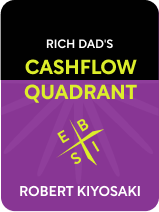

This article is an excerpt from the Shortform book guide to "Rich Dad's Cashflow Quadrant" by Robert T. Kiyosaki. Shortform has the world's best summaries and analyses of books you should be reading.
Like this article? Sign up for a free trial here .
What does it mean to be financially free? Do you think you have what it takes to achieve total financial freedom?
To Robert Kiyosaki, financial freedom means never having to work again. In his book Rich Dad’s Cashflow Quadrant, he says that everybody should strive to transcend job security and achieve financial freedom. However, he admits that not everybody is ready for the risks and the sacrifices the path of financial freedom demands.
Here is what Kiyosaki has to say about financial freedom.
Money Is Freedom
The ultimate purpose of wealth is to have the freedom to spend your time the way you want. But it isn’t the only type of freedom wealth brings. According to Kiyosaki, the ultimate goal of building wealth is a step further—financial freedom. The financially free can do nearly whatever they want, whenever they want because money is almost never an obstacle. According to Robert Kiyosaki, financial freedom should be your ultimate goal.
While Kiyosaki focuses on how to achieve 1-percenter, capitalist-level financial freedom, where all your time is yours and almost nothing is out of reach, he says the principles he puts forward are equally useful for reaching financial security. Even if you’re not willing to commit yourself to the risks and lifestyle it takes to achieve financial freedom, Kiyosaki thinks that, at minimum, you should strive for a life where concerns about money don’t dictate the way you live.
Ultimately, Kiyosaki wants you to transcend job security, where your life is defined by the dollar amount on your paycheck and the parameters of your day-to-day work. To Kiyosaki, if all you have is job security, all you have is job dependency.
| Financial Freedom vs. Financial Independence In contrast to Kiyosaki’s focus on financial freedom, Sethi, and most of the personal finance community, stress the importance of “financial independence.” This is the point at which your passive income can pay for all your expenses and you no longer have to work. Financial independence offers more freedom, as Kiyosaki defines it, than financial security, because you no longer need to work. When Kiyosaki talks about financial freedom, he’s usually talking about capitalist-level wealth. In contrast, financial independence can mean 1% level wealth, but since it only means that your passive income is greater than your expenses, you can be financially independent with much less wealth. Some of this difference between “financial freedom” and “financial independence” is semantic, but it’s useful to know what these terms are most likely referring to when you hear them. |
The Crucial Mental Skills for Financial Success
Attaining financial freedom is as much a matter of skill in business and investing as it is about cultivating the mental fortitude to stick it through long-term.
Key to Success #1: Be Financially Literate
According to Kiyosaki, there are two groups of people: people who understand how money flows and grows, and people who don’t. Those who don’t usually remain solely in E and S categories, without assets or the possibility of growing their income into wealth and destined to make money for other people.
On the other hand, people who are fluent in money know that the best way to wealth is to be in the B and I categories, and they end up making money for themselves. An understanding of money, finance, business and investing is crucial in generating wealth, whether you’re looking to work in business and investing full time, or supplement your E and S income with passive income from investing.
(Shortform note: It’s harder, and more important, to be financially literate today than it was in the past. Financialization of the U.S. economy has meant saving, investment, and retirement options are now more complicated than they’ve ever been. Between 1950 and 2019, the financial sector’s share of the U.S. GDP rose from about 3% to over 20%.)
- Be an active learner. Because we don’t receive an adequate financial education from our parents, from secondary schools, or in college, you’ll need to be purposeful about developing your financial education. Learn by doing, consider furthering your formal education, and commit yourself to independent research.
(Shortform note: When Kiyosaki wrote Rich Dad’s Cashflow Quadrant, the internet was nowhere near as ubiquitous as it is now. Email newsletters can be a great way to learn about investing or a particular industry, or develop your financial knowledge in general. They can also help you cut through the seemingly endless advice on the internet.)
Key to Success #2: Become Mentally Prepared to Succeed
In both the B and I categories, you need to develop mental and emotional fortitude. Both starting out in the B and I categories, and especially transitioning from the E and S categories to the B and I categories, are long, tough challenges.
- Get over your fear of money. Kiyosaki says fear of money—fear that you don’t understand it, fear that you won’t have enough, fear of taking financial risks or a thousand other worries related to money—makes sense. But before you can make any change to your financial situation, Kiyosaki emphasizes that you need to have a healthy relationship with money.
(Shortform note: In Your Money or Your Life, Vicki Robin agrees that a core part of financial freedom is freedom from fear and worry about money. She argues that by consciously connecting money to your values, purpose, and dreams, you can diffuse some of your financial anxiety.)
- Get started ASAP. Undertaking a goal as big as succeeding as the owner of a large business or learning to invest can be paralyzing. Take baby steps because they’re much easier to start, and build your wealth as you build your skills.
(Shortform note: Kiyosaki emphasizes that the journey to financial security and freedom is a marathon, not a sprint. James Clear’s concept of “atomic habits” from his book of the same name is useful for breaking down a big undertaking into smaller parts. Atomic habits are small adjustments that are easier to start and will eventually compound into changed behavior.)
- Believe in yourself and have determination. Set yourself up for success by expecting to be successful in the long run. Your ability to succeed depends on your ability to respond to challenges without being knocked off your path; grittiness is essential.
(Shortform note: In her book Grit, Angela Duckworth argues that between two people with equal ability, the grittier person will achieve more success, and that grit is a skill that can be honed with practice.)

———End of Preview———
Like what you just read? Read the rest of the world's best book summary and analysis of Robert T. Kiyosaki's "Rich Dad's Cashflow Quadrant" at Shortform .
Here's what you'll find in our full Rich Dad's Cashflow Quadrant summary :
- Why the traditional path of college to career doesn't work
- Which types of income will lead you to financial freedom
- An in-depth look at Robert Kiyosaki's four cashflow quadrants






